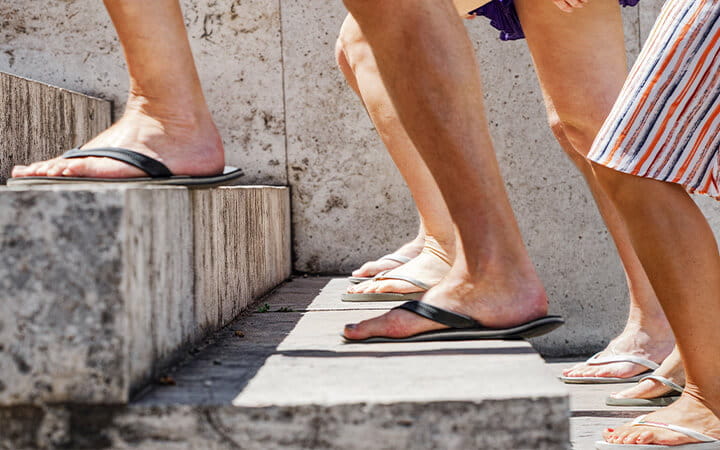The Health Hazards of Summer Slides and Flip-Flops
July 22, 2025

Lightweight and easy to slip on and off, summer sandals may seem comfortable at first, but wearing them can lead to painful problems. “If you're spending a lot of time in in slides and flip-flops, you may increase your risk of foot pain and wear-and-tear symptoms like those that come with arthritis,” says Jessica Milliman, DPM, a podiatrist at University Hospitals.
Comfortable at a Cost
While they seem like a relaxed choice for summer days and nights, flip-flops and other summer shoes can increase your risk of:
- Plantar fasciitis (when the stretchy, rubber band-like plantar fascia tissue that runs from your heel to your toes becomes inflamed).
- Achilles tendonitis (when the tissue that connects your calf muscle to your heel gets inflamed).
- Stubbing or scraping your toes, which could lead to bruising or infection.
- Spraining your ankle.
- Getting bit or stung by insects on your feet.
- Exacerbating conditions like bunions.
It’s not only your feet that can be impacted. Other areas of the body can be affected too. “Think back to the popular kids’ song,” says Dr. Milliman. “The foot bone’s connected to the heel bone, the heel bone’s connected to the ankle bone, the ankle bone’s connected to leg bone and so on,” she says. “Improper shoes can lead to ankle, knee, hip and back pain.”
How Your Feet Change as You Age
As you age, wearing unsupportive summer shoes can become even more risky. “Our feet change as we age, which can lead to more foot pain,” says Dr. Milliman. The size or shape of our feet can change. Ligaments and tendons tend to get weaker. Joints can become more stressed. Arthritis may also be an issue for some people.
Like the rest of your skin, the skin on the feet may begin to lose elasticity as you age, becoming thinner and drier. The toenails may get brittle and harder to cut. Foot problems are also more common in older people with chronic conditions like diabetes, which can result in diabetic neuropathy (loss of sensation in the feet).
Dr. Milliman says older people should wear summer shoes like flip-flops with caution. “If they’re too flimsy, they can be a tripping hazard,” she says. Additionally, she warns that if you spend a lot of time at home just walking around your house in slippers or socks, it can make foot pain from age-related wear and tear worse. “I usually recommend having a pair of athletic shoes to wear when spending long periods of time indoors,” she says. “Make sure to stretch and strengthen your muscles and tendons as you get older to help stay limber.”
5 Tips for Choosing the Right Summer Shoes
Investing in better summer footwear now can help you avoid pain and visits to the podiatrist later.
- Seek out sturdy styles. “Wearing an athletic-style shoe that’s more stiff and supportive can decrease or relieve foot pain,” says Dr. Milliman. “In general, I recommend a shoe that does not twist or bend.”
- Look for adequate cushioning. “A thicker sole can usually provide more support,” she says.
- Go for stability. Opt for adjustable straps around the heel or ankle rather than going with slip-ons.
- Be mindful of the fit. “Proper fit of the shoe is key,” says Dr. Milliman. Your summer shoes should not be too big or too small. “You don’t want your heels falling out of the shoe or too much movement in the toebox.”
- Consider your summer activities. More support is needed when walking long distances or engaging in sports or other outdoor recreation.
There may still be occasions when you want to wear slides or flip-flops to the beach or strappy sandals to an event. If you only have them on for short periods, you’re at lower risk for potential problems, says Dr. Milliman. “Aim to wear a supportive type of shoe about 80 percent of the time,” she says. “The other 20 percent of the time, you can be in a more flexible type of shoe, if desired.”
Related Links
University Hospitals offers expert foot and ankle care through a network of skilled specialists. We treat a wide range of conditions, helping reduce pain, improve mobility and enhance quality of life.


